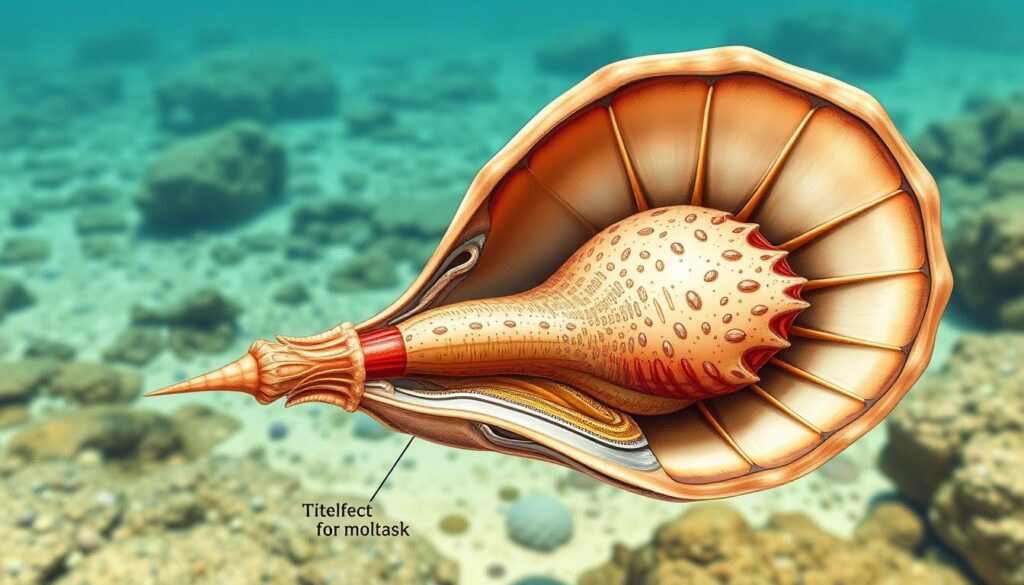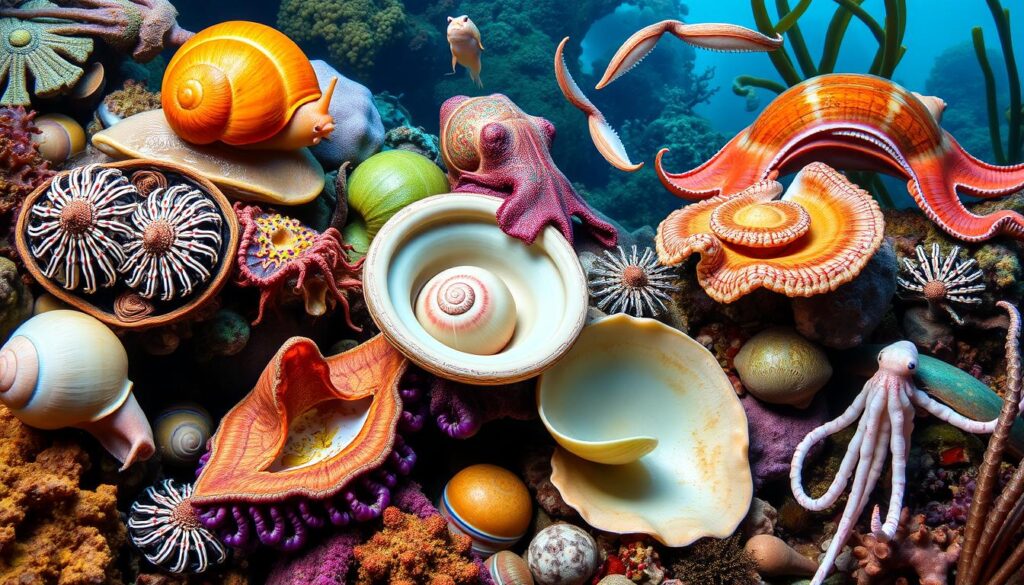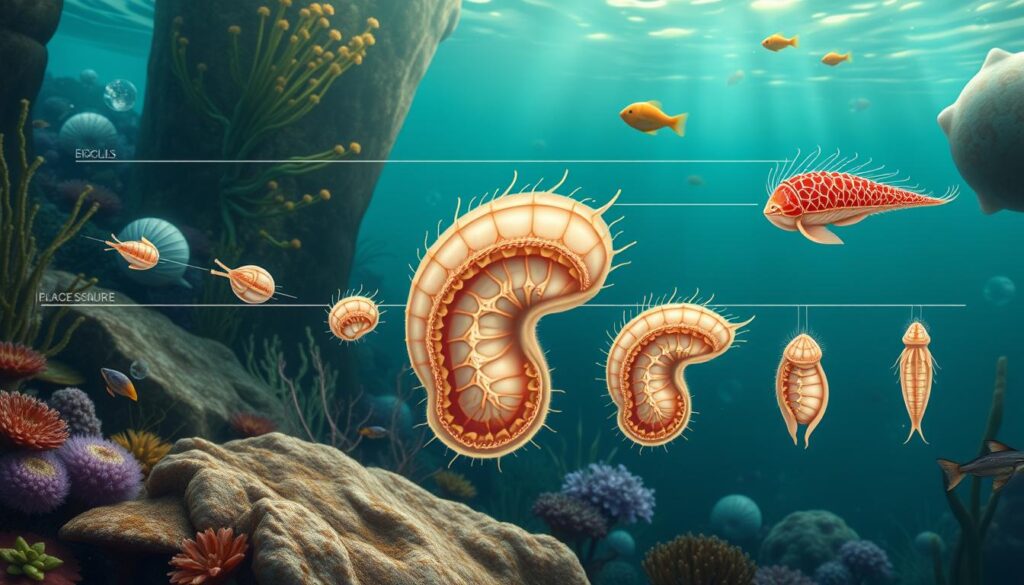Explore the amazing world of mollusk anatomy. Here, nature’s design shows a body structure that has evolved over millions of years. You’ll learn about the three main parts that make mollusks special in the animal kingdom.

The phylum Mollusca is a group of invertebrate animals. They have about 85,000 species living in different places, from deep oceans to land. Their anatomy is made of three key parts: the head-foot complex, visceral mass, and protective mantle.
These three parts are vital for a mollusk’s survival. They help with movement, sensing the world, protecting organs, and making shells. Together, they help mollusks live in many tough environments.
Table of Contents
Introduction to Mollusks and Their Anatomical Structure
Mollusks are fascinating and diverse creatures. They have over 50,000 known species. These animals live in many places, from deep oceans to land.
- A soft body covered by a calcium shell
- A special mantle for breathing and waste
- A muscular foot for moving
Evolution and Diversity of Mollusks
Mollusks first appeared about 541-485.4 million years ago. They have evolved into many species. These include snails, slugs, clams, mussels, octopuses, and squids.
| Mollusk Class | Species Count | Notable Examples |
|---|---|---|
| Gastropoda | 40,000 | Snails, Slugs |
| Bivalvia | 8,000 | Clams, Mussels |
| Cephalopoda | 600 recent | Octopuses, Squids |
Basic Characteristics of Mollusk Bodies
Mollusk bodies are made for efficiency. They have soft muscles, a protective mantle, and a special nervous system. This helps them survive in different places. Most mollusks have two nerve cords and separate organs for reproduction.
Importance in Animal Kingdom
Mollusks are vital in ecosystems. They are food for many animals and people. Some are even used as money, showing their value in culture and economy.
“Mollusks are not just creatures, they are living testimonies to nature’s innovative design capabilities.” – Marine Biology Research Institute
By studying mollusk anatomy, we learn about evolution and diversity.
The Fundamental Components of Mollusk Bodies
Mollusks are a fascinating group of organisms with unique body systems. These systems have evolved over millions of years. What are mollusk bodies composed of? They have a complex structure that makes them stand out in the animal kingdom.
- Head-Foot Complex
- Visceral Mass
- Protective Mantle
Each part is crucial for the mollusk’s survival. Their soft, unsegmented bodies are symmetrical. This symmetry helps them move efficiently and adapt to different environments. Mollusks have special structures that make them very versatile.
“Nature’s design in mollusks demonstrates remarkable evolutionary ingenuity.” – Marine Biologist Dr. Elena Rodriguez
Now, let’s look at the key features of mollusk body systems:
| Body Component | Primary Function | Key Features |
|---|---|---|
| Mantle | Protection and Shell Formation | Secretes calcareous structures, creates breathing cavity |
| Radula | Feeding Mechanism | Chitinous “tongue” with rasping teeth |
| Nervous System | Coordination and Sensing | Paired nerve cords, brain surrounding esophagus |
With approximately 100,000 known species, mollusks show incredible diversity in their body systems and adaptations. From tiny sea snails to giant clams, these organisms amaze scientists and marine enthusiasts.
The Head-Foot Complex: Primary Movement and Sensory Center
Mollusks have a special head-foot complex. It’s their main way to move and sense the world. This complex is key to how they interact with their surroundings.
Sensory Organs and Nervous System
Mollusk sensory organs are very advanced. They help these creatures navigate and understand their environment. Their nervous system has special parts that detect:
- Chemical signals in the environment
- Vibrations and touch
- Light and visual cues
- Gravitational changes
Locomotion Mechanisms
Mollusk movement varies a lot between species. This shows their amazing adaptability. The muscular foot allows for different ways to move:
- Crawling along surfaces
- Burrowing through sediment
- Swimming in aquatic environments
Feeding Structures
Mollusks have unique ways to eat. They use the radula, a special organ, to rasp and collect food. Ciliary currents help move food through their digestive tract.
The head-foot complex is a marvel of evolution in mollusks. It’s all about sensing and moving.
The Visceral Mass: Internal Organ Systems
Explore the amazing world of mollusk internal organs. The visceral mass is a key area that holds many important systems. These systems help these creatures live and thrive. It’s a fascinating look into the biology of mollusks.
The visceral mass function includes several vital biological systems:
- Digestive system with extensive digestive ceca
- Reproductive organs for species continuation
- Kidney-like excretory structures
- Open circulatory system with unique hemocoel
“The visceral mass is essentially the biological command center of mollusk anatomy” – Marine Biology Research Institute
There are about 85,000 known mollusk species. Each has its own special internal organ setup. These setups show how mollusks have evolved in amazing ways.
| Organ System | Primary Function | Unique Characteristics |
|---|---|---|
| Digestive | Nutrient processing | Large digestive ceca |
| Circulatory | Blood circulation | Open hemocoel system |
| Excretory | Waste removal | Specialized kidney-like organs |
Learning about mollusk internal organs gives us a deep look into their complex biology. Each part of the visceral mass shows nature’s incredible design.
The Mantle: Protective Covering and Shell Formation
The mollusk mantle is a remarkable part of marine life. It acts as a shield and is key in making and fixing shells. It also helps with breathing for many mollusks.
Knowing about the mantle is essential for understanding mollusks. It’s found on the back and is vital for creating and keeping the shell strong.
Shell Structure and Development
Building a mollusk shell is a complex process. It involves many biochemical steps. The shell has three main parts:
- Outer protective periostracum layer
- Middle prismatic calcite layer
- Inner nacre (mother-of-pearl) layer made of aragonite crystals
The shell is made of about 2% protein, which is as strong as steel in concrete. Many proteins work together to grow the shell perfectly.
Respiratory Functions
The mantle helps mollusks breathe. It has special areas for:
- Oxygen exchange
- Filtering water for food
- Removing waste
The mantle is nature’s smart design for protection, breathing, and survival in the sea.
| Shell Layer | Primary Composition | Key Function |
|---|---|---|
| Periostracum | Organic material | External protection |
| Prismatic | Calcite | Structural support |
| Nacre | Aragonite crystals | Smooth internal surface |
Learning about the mollusk mantle shows how amazing and complex these sea creatures are.
Mollusk Bodies: Variations Across Different Species
The world of mollusk species is full of amazing body variations. From tiny sea snails to huge squids, these creatures show incredible diversity. Their bodies reflect their unique paths in evolution.

Different mollusk species have bodies that help them live in many places. Let’s look at some interesting examples:
- Gastropods are the most diverse group with about 85,000 living species
- Cephalopods have complex brains and special body shapes
- Bivalves have shells that open and close, perfect for water and land
Evolution has made mollusk bodies very different. For example, chitons have cool eyes that they developed on their own.
Chitons evolved eyes independently four times, with eyespots emerging within just 7 million years in certain neotropical genera.
Here’s a table that shows how diverse mollusk species are:
| Mollusk Group | Living Species | Primary Habitat |
|---|---|---|
| Gastropods | 85,000 | Marine, Terrestrial |
| Bivalves | 30,000 | Marine, Freshwater |
| Cephalopods | 800 | Marine |
| Chitons | 1,000 | Marine |
Every mollusk species has its own special body. These bodies show how they’ve adapted to their environments. Their diversity is a big interest for scientists and marine biologists everywhere.
Circulatory and Respiratory Systems in Mollusks
Mollusks show us how unique biological systems can be. Their circulatory system is a key part of their amazing evolution.
Mollusks have an open circulatory system. This is different from most animals. Their blood bathes their organs directly, not flowing through tubes.
Open Circulatory System Characteristics
- Blood flows freely within the body cavity (hemocoel)
- Heart pumps hemolymph through limited vessel networks
- Lower energy expenditure compared to closed systems
- Allows for direct nutrient and waste exchange
Specialized Breathing Organs
Mollusk breathing organs vary a lot. Sea creatures have gills. Land mollusks have special lungs in their mantle.
“Nature’s diversity shines through the remarkable respiratory adaptations of mollusks” – Marine Biologist Dr. Elena Rodriguez
Each mollusk has its own way of breathing:
- Marine snails use special gills for oxygen
- Land snails have a lung-like part in their mantle
- Cephalopods have complex breathing systems
The design of mollusk breathing organs lets them live in many places. It shows how adaptable these creatures are.
Digestive and Excretory Functions
Mollusks have fascinating digestive and excretory systems. These systems show amazing biological adaptations. Their digestion process is complex, using special structures to extract nutrients from food.
- Mouth with a unique feeding structure called radula
- Specialized esophagus
- Complex stomach region
- Extended intestinal tract
Mollusk excretion happens through special organs called metanephridia. These organs filter waste from the blood and remove it through the mantle cavity.
“The radula acts like a microscopic rasping tongue, allowing mollusks to scrape and consume diverse food sources with remarkable efficiency.”
Different mollusk species have different digestion methods. For example, bivalves have a two-phase digestion:
- Extracellular digestion in the stomach
- Intracellular digestion within digestive diverticula
The excretory system includes paired looped kidneys with specific openings. These help keep the mollusk’s internal balance. These complex systems show how adaptable mollusks are in different environments.
Reproductive System and Life Cycle
Mollusks have amazing ways of reproducing. This shows their incredible diversity. Learning about mollusk reproduction opens up a world of complex life cycles.

- External fertilization in marine environments
- Internal fertilization in some specialized species
- Hermaphroditic reproductive systems
- Unique egg-laying strategies
Sexual and Asexual Reproduction Methods
Mollusks are very flexible in how they reproduce. Some release gametes into the water, while others have complex internal fertilization. Hermaphroditism is common in some species, allowing them to produce both male and female cells.
Development Stages
The development of mollusks is full of interesting stages:
- Egg production ranging from a single egg to thousands
- Formation of trochophore larvae
- Potential transformation into veliger larvae
- Maturation into juvenile or adult forms
Some gastropod species produce up to 1,000 eggs in a single reproductive cycle, showcasing their remarkable reproductive potential.
Mollusks have different ways of reproducing based on their habitat. Marine species often have planktonic larvae. Terrestrial and freshwater mollusks develop more directly. Their complex reproductive systems show how adaptable these creatures are.
Adaptations and Specialized Body Features
Mollusks have developed amazing adaptations that show nature’s creativity. Their unique features help them live in many places, from hot deserts to the deep sea.
Some of the most interesting adaptations include:
- Shell changes for protection and buoyancy
- Ink sacs in cephalopods for defense
- Bioluminescence in deep-sea species
- Advanced sensory systems
Cephalopods like octopuses have incredible features. Their eyes can spot small light changes. They can also change color for better camouflage. Some even have toxic defenses.
“Nature’s ingenuity in mollusk adaptations is a testament to survival and evolutionary brilliance.”
Marine environments have led to unique adaptations. About 7% of marine animals are mollusks. Each species has its own survival strategy. Some live with bacteria or algae, while others use complex chemical signals.
- Venomous cone shells
- Blue-ringed octopus toxins
- Burrowing capabilities
- Respiratory adaptations
Learning about these creatures shows how mollusks keep surprising scientists. They continue to amaze with their evolutionary innovations.
Environmental Influence on Mollusk Anatomy
Mollusks are incredibly adaptable, surviving in many different environments. Their bodies show amazing adaptations for living in tough places.
Learning about mollusk survival starts with how they change their bodies for their environment. Each species has special traits for extreme conditions.
Habitat-Specific Modifications
Marine mollusks have amazing ways to deal with different conditions:
- Deep-sea species have smaller shells to handle pressure
- Intertidal mollusks have strong shells for waves
- Freshwater bivalves have special filters
Survival Mechanisms
Mollusks use smart ways to stay safe:
- They use chemicals to defend against predators
- They can blend in with their surroundings
- They have advanced senses to detect threats
“Nature has equipped mollusks with incredible survival tools that continue to fascinate researchers worldwide.”
Mollusks are important for showing us about the health of our environment. They show how well they can live with their surroundings.
Conclusion
Exploring mollusk anatomy shows us nature’s amazing adaptability. It highlights how mollusk bodies are key in ecosystems around the world. From their complex heads to protective mantles, mollusks show incredible diversity.
The main parts of a mollusk – head-foot complex, visceral mass, and mantle – are true wonders of nature. Each species has special features that help them survive in different places. Learning about mollusk anatomy helps us understand how they live and interact with their environments.
Mollusks are more than just interesting creatures. They help keep ecosystems balanced and tell us about environmental health. They also offer important resources for people. Their ways of reproducing are very different, with some being hermaphroditic and others having separate males and females.
As scientists keep studying mollusks, we’ll learn even more about how they adapt and survive. Your exploration of mollusk anatomy shows us the amazing complexity and strength of these creatures.
FAQ
What are the three main parts of a mollusk’s body?
A mollusk’s body has three main parts. The head-foot complex helps with movement and senses. The visceral mass holds the internal organs. The mantle covers the body and makes the shell.
How do mollusks breathe?
Mollusks breathe in different ways. Sea creatures use gills in their mantle cavity. Land creatures have lung-like parts. Some use their mantle for gas exchange, fitting their environment.
Do all mollusks have shells?
No, not all mollusks have shells. Snails and clams have big shells, but slugs and octopuses don’t. Their shells are made of proteins, chitin, and calcium carbonate, created by the mantle.
How do mollusks move?
Mollusks move in various ways. Snails crawl, clams burrow, and squids swim. They use their muscular foot for movement, thanks to the head-foot complex.
What is a radula?
A radula is a special feeding tool for most mollusks (except bivalves). It’s like a chitinous “tongue” with tiny teeth for scraping food. It helps them eat and process their food.
How do mollusks reproduce?
Mollusks reproduce in many ways. Some have external fertilization, others internal. Many are hermaphroditic, with both male and female parts. They lay eggs that hatch into larvae, with different life cycles in different environments.
Where do mollusks live?
Mollusks live in many places. They’re found in oceans, lakes, rivers, forests, deserts, and even extreme places like deep-sea vents. Their ability to adapt lets them live almost everywhere on Earth.
How many species of mollusks exist?
There are about 85,000 known living mollusk species. This group includes snails, slugs, clams, squids, and octopuses. They started evolving during the Cambrian period, over 541 million years ago.

